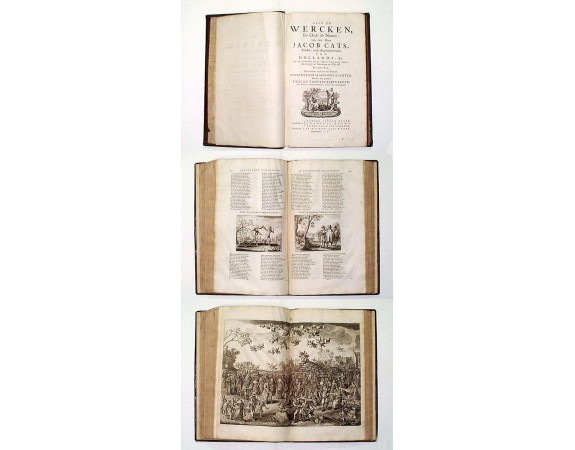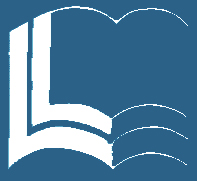CATS,J. - Alle de Wercken so Oude als Nieuwe.
 Click on image to zoom
Click on image to zoom

CATS,J. - Alle de Wercken so Oude als Nieuwe.
Published: Amsterdam, 1700
Size: 415 x 265mm.
Color: Uncolored
Condition: 2 Volumes in contemp. brown calf, spine richly gilt in compartments, 2 red title-labels. Engraved titles, 2 portraits, 3 double-page plates, and over 400 engravings.
Description
A very good example of the collected works of the most celebrated Dutch author of the seventeenth century. Illustrated with over 400 engravings after van de Venne by Hondius, Van Queboren, Matham a.o. All plates are very dark impressions.
First published in 1655. Two folio volumes, each with additional engraved title page bearing a portrait of the author, as well as sectional title pages with engraved vignettes. [28],666 [i.e. 662: 183-184 repeated and 343-348 omitted],[10]; [18],390,[6],393-608,61,[1] pp, with full-page portraits of the author and of Anna Maria Schurman, three double-page plates, and more than 400 superb copper-engraved half- and quarter-page plates (most from the original designs of Adrian van de Venne), numerous tailpieces of bouquets, and historiated initials.An example in fine contemp. calf bindings, occasional some minor marginal browning, else fresh and bright with rich impressions of type and plates.
Cats was a Dutch statesman and writer of emblem books, a type of popular, seventeenth-century literature consisting of woodcuts or engravings accompanied by didactic verses pointing a moral or presenting an ethical concern often related to love and marriage. (Dutch artists of the Golden Age, including Vermeer, used such books as inspiration for motifs in their paintings and prints.) The sources upon which Cats draws for this combination of emblem literature and love poetry are chiefly the Bible and the classics and occasionally Boccaccio and Cervantes.
His first book, Sinne-en minnebeelden ("Portraits of Morality and Love") contained 96 emblematic engravings with text in Dutch, Latin, and French, each emblem with a threefold interpretation, expressing what were for Cats the three elements of human life: love, society, and religion. Perhaps his most famous emblem book, written in a more homely style than his earlier works, is Spiegel van den ouden en nieuwen tyt ("Mirror of Old and New Times"), with 128 emblematical engravings accompanied by quotations, many of which have become household sayings. Two other worksâ "Houwelyk ('Marriage') and Trou-ringh ('Wedding Ring'), with 59 plates "are rhymed dissertations on marriage and conjugal fidelity.
Finally, in one of his last books, Ouderdom, buyten-leven en hof-gedachten ("Old Age, Country Life, and Garden Thoughts"), with 27 plates, Cats writes movingly about his declining years. (Encyclopedia Britannica)
First published in 1655. Two folio volumes, each with additional engraved title page bearing a portrait of the author, as well as sectional title pages with engraved vignettes. [28],666 [i.e. 662: 183-184 repeated and 343-348 omitted],[10]; [18],390,[6],393-608,61,[1] pp, with full-page portraits of the author and of Anna Maria Schurman, three double-page plates, and more than 400 superb copper-engraved half- and quarter-page plates (most from the original designs of Adrian van de Venne), numerous tailpieces of bouquets, and historiated initials.
Cats was a Dutch statesman and writer of emblem books, a type of popular, seventeenth-century literature consisting of woodcuts or engravings accompanied by didactic verses pointing a moral or presenting an ethical concern often related to love and marriage. (Dutch artists of the Golden Age, including Vermeer, used such books as inspiration for motifs in their paintings and prints.) The sources upon which Cats draws for this combination of emblem literature and love poetry are chiefly the Bible and the classics and occasionally Boccaccio and Cervantes.
His first book, Sinne-en minnebeelden ("Portraits of Morality and Love") contained 96 emblematic engravings with text in Dutch, Latin, and French, each emblem with a threefold interpretation, expressing what were for Cats the three elements of human life: love, society, and religion. Perhaps his most famous emblem book, written in a more homely style than his earlier works, is Spiegel van den ouden en nieuwen tyt ("Mirror of Old and New Times"), with 128 emblematical engravings accompanied by quotations, many of which have become household sayings. Two other worksâ "Houwelyk ('Marriage') and Trou-ringh ('Wedding Ring'), with 59 plates "are rhymed dissertations on marriage and conjugal fidelity.
Finally, in one of his last books, Ouderdom, buyten-leven en hof-gedachten ("Old Age, Country Life, and Garden Thoughts"), with 27 plates, Cats writes movingly about his declining years. (Encyclopedia Britannica)
1,900€
- Reference N°: 07270
